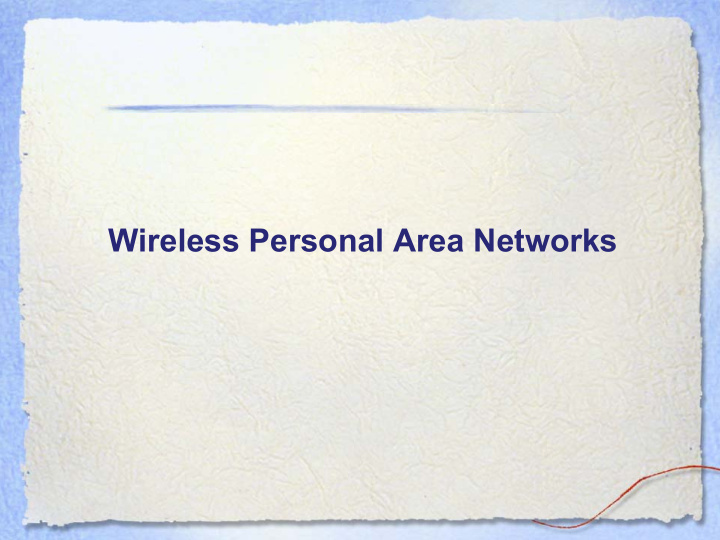



Wireless Personal Area Networks
Bluetooth (802.15.1) - Basic Specs • Communication Range – 10 m at 1 mw transmission power – 100 m at 100 mw transmission power • Data rate ~700 Kb/s • Radio parameters – 2.4 GHz band – Frequency hopping over 79 channels – Channel spacing = 1 MHz
Bluetooth Architecture • Master-slave connection • Several slaves and a master form a piconet • Several piconets form a scatternet • Piconets – Master and up to seven slaves – Can only be one master per piconet – Slaves must synchronize to master – Master announces its clock and device ID to slaves – Hopping pattern determined by master’s device ID – Hopping pattern phase determined by master’s clock
Piconet Details • Channel divided into 625 µ s slots • Hop occurs after each packet transmitted • Packets can be 1, 3, or 5 slots in length • Up to 1600 hops / second • Time division duplex – Transmit and receive in alternate time slots – Master transmits in a slot and slave transmits in following slot • Master schedules all traffic, scheduling algorithm not specified in Bluetooth standard
Scatternets • Slaves within a piconet share 1 MHz bandwidth • Piconets can co-exist by hopping independently • Scatternets share 79 MHz bandwidth among different piconets • Nodes can belong to multiple piconets – Time division multiplexing – Can be a slave in two different piconets – Can be a master in one piconet and a slave in another piconet – Currently no standard for synchronization between different piconets
802.15.4 - Basic Specs • Communication range = 30 m • Data rates of 250 kb/s, 40 kb/s, and 20 kb/s • Star or Peer-to-Peer operation • CSMA-CA channel access • Handshaked protocol for transfer reliability • Low power consumption • Frequency Bands of Operation – 16 channels in the 2.4GHz ISM band – 10 channels in the 915MHz ISM band – 1 channel in the European 868MHz band.
802.15.4 Device Classes • Full function device (FFD) – Any topology – Network coordinator capable – Can talk to any other device • Reduced function device (RFD) – Limited to star topology – Cannot be a network coordinator – Can talk only to a network coordinator – Very simple implementation
Star Topology PAN Coordinator Master/slave Communications flow Full function device Reduced function device
Peer-Peer Topology Point to point Cluster tree Full function device Communications flow
Combined Topology Interconnected stars - for example, each room in a hotel has a star network for control and coordinator nodes communicate information between rooms Communications flow Full function device Reduced function device
Recommend
More recommend